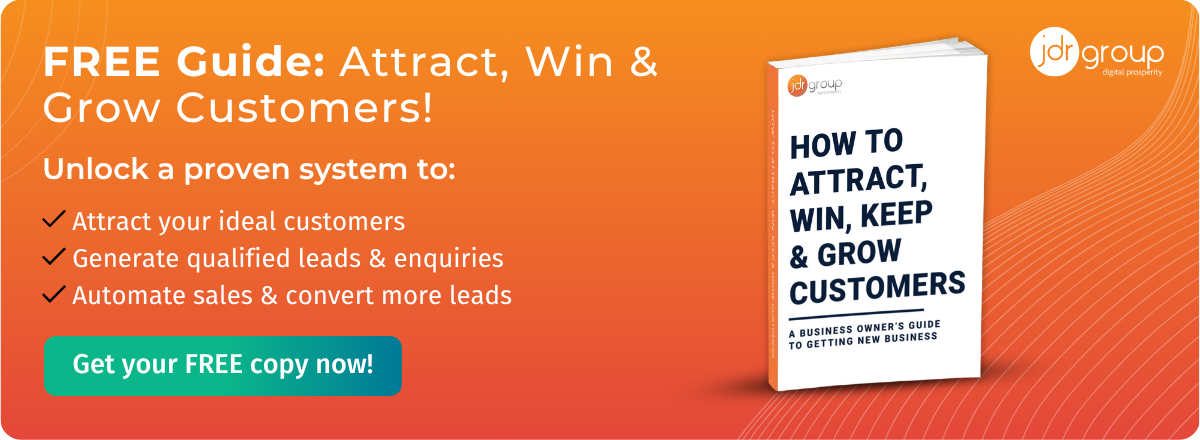Inbound Marketing Strategies for Scaling Your SaaS Business
by Will Williamson on 08-May-2025 12:30:00

Inbound marketing strategies are a perfect fit for Software as a Service (SaaS) businesses looking to scale within a digital marketplace. Your target customers are likely to be digital natives who are comfortable purchasing services online and are familiar with the benefits of the subscription-for-access model. This gives you the opportunity to create a hard-hitting marketing plan based on the value of your service, reaching out to your target audience, and nurturing your leads until they are ready to convert. The same strategy can also be used to reduce churn among existing customers. Here are 10 steps to success in digital inbound marketing:
1. Test The Best Conversion Approach For Your Platform
Not all of your potential customers will take the same path towards conversion. Some will sign up for a subscription the first time they visit your website – your ‘golden customers’. Others may prefer to book a demo or trial period before committing to a longer subscription, and some customers may want to contact your team directly for questions before they decide either way. Other customers expect a free or ‘lite’ version of your product so they can assess its value (e.g. HubSpot, Trello). Testing different conversion scenarios and approaches can reveal what resonates most with your audience, so that you can get your CTAs (calls to action) and offers right. A good way to do this is A/B testing using different landing pages, sections of your website, email marketing, and ad campaigns. Carefully track metrics such as signup rates, demo requests, subscriptions, and engagement levels for each option to identify the one that drives the most conversions.
2. Create Comparison Content
Digital subscription customers often review two or more similar services before making a purchase decision in an informal ‘competitor analysis’ process. Although subscription services are still popular, subscription fatigue is a growing factor in some sectors, making customers choosier. A good way to help them make a decision in your favour is to focus on comparison content with your main competitors – e.g. “HubSpot vs Mailchimp”, “Spotify vs Apple Music”. These types of articles, e-books, and landing pages are good at capturing consideration stage visitors who may have already done some initial research, and also help to instil confidence in decision-makers researching their options. Use your content to highlight your platform’s unique strengths and benefits while also being courteous, factual and transparent about your competitors.
3. Use Targeted LinkedIn ads
LinkedIn is one of the most effective advertising platforms for quickly reaching decision-makers. With robust and versatile targeting capabilities, you can target your adverts at the specific industries, company sizes, locations, and job roles that align with your ideal customer profiles/buyer personas. LinkedIn advertising is great for lead generation campaigns and for promoting premium gated content. Inbound leads can be nurtured further along the sales funnel either through LinkedIn or by email marketing, with content that highlights how your platform solves unique business pain points and delivers long-term value.
4. Create ‘Top Of The Funnel’ Content
Top of the funnel (TOFU) content is an important part of content marketing for SaaS businesses. TOFU is designed to attract and engage customers who are just starting their journey by considering a problem or challenge they need to overcome – i.e. customers at the ‘awareness’ stage. The purpose of this content is to raise more awareness, provide value, get your business name out there, and start building trust without being too salesy. For instance, if your platform improves team productivity and collaboration, your content should explore ways that customers can streamline their workflows and boost productivity, and maybe improve data security, without necessarily mentioning your platform explicitly. This can position you as an authority in your market and help you gather contact details through on-page forms. Start with a blog and expand the content in more depth with a gated e-book in exchange for an email address and/or phone number.
5. Use Video To Demonstrate Your Platform
Video is a powerful medium for SaaS content marketing, and can be used to demonstrate how your platform looks and works on different screen sizes and devices. Publish videos that show the platform being used in real-world scenarios, such as on the shop floor, in the warehouse, or in the office, to give your target customers an intuitive understanding of how it can support them in their own work and life. Short platform demonstrations, customer testimonials, and even explainer videos work well to engage potential subscribers. These videos can be embedded directly onto your website, published on your YouTube channel, or shared across social media and email campaigns.
6. Invest In Pay Per Click (PPC) Advertising
As an overwhelmingly digital-focused market, SaaS vendors frequently benefit from heavy investment in PPC advertising to reach high-quality leads and increase brand visibility to their target audience. SaaS keywords tend to be highly competitive on PPC platforms, which drives up the cost per click and cost per acquisition rates. Instead of purely targeting the most competitive keywords, therefore, get creative with your choices, focusing on long-tail keywords that align with your specific audience’s intent and the features of your platform. While the costs of PPC can deter some businesses, be aware that a well-targeted campaign will usually translate into a higher ROI over time, with better lead quality and more conversions.
7. Overcome Long Sales Cycles With Marketing Automation
Depending on your contract terms and sector, some SaaS purchase decisions involve a long sales cycle, often requiring multiple touchpoints before a lead converts. This can cause a problem for SaaS vendors with a small number of employees and limited customer service and sales resources. To streamline this process, you should invest in an agile marketing automation platform to help nurture and score your leads automatically. A platform such as HubSpot will allow you to manage and integrate all your digital marketing channels within a single dashboard, and equip your internal stakeholders with the resources they need to follow up leads and progress sales.
8. Publish a High-Performing Pricing Page
If you are doing your job correctly, your ‘prices’ page should be one of the most visited locations of your website! It also plays a critical role in informing and converting potential customers. Time spent designing a pricing page that is clear, transparent, and aligned with your customer expectations is, therefore, time well spent. Clearly explain your different pricing tiers and offers, list the features included in each subscription, and make sure that prospects can quickly understand the value of your platform so they can make an informed decision.
9. Use Customer Reviews And Testimonials
Social proof is an effective way of selling subscription-based software, as well as building credibility in a competitive SAS market. Use customer reviews, testimonials, and case studies liberally throughout your website, blog articles, social media platforms, and gated content. Ideally, use reviews from customers similar to your target market to make them relatable and compelling, including measurable results (e.g. cost or time savings, ROI, etc), to make your success stories more realistic.
10. Educate Your Target Customers
Ultimately, education, not sales, is the beating heart of inbound marketing. The goal is to bring someone from a position of not knowing a thing about your platform to the stage where they want to sign up for a multi-year subscription, and hopefully recommend you to their friends, family, and colleagues while they’re at it. It therefore pays dividends to invest in your content: write (or outsource) detailed professional articles, publish high-quality e-books, record video tutorials, and respond to comments on social media to address challenges and provide solutions, for free. This nurturing approach will help boost your brand authority and credibility over time, increasing organic traffic and conversions.
Find out more
Get in touch with one of the inbound marketing specialists at JDR today to find out how you can use digital channels to your advantage to scale your business this year.
- Inbound Marketing (SEO, PPC, Social Media, Video) (824)
- Strategy (363)
- Sales & CRM (195)
- Marketing Automation & Email Marketing (190)
- Business Growth (164)
- Website Design (160)
- Hubspot (138)
- Lead Generation (115)
- Google Adwords (98)
- Content Marketing (94)
- Conversion (48)
- Case Studies (47)
- News (47)
- Ecommerce (39)
- Webinars (34)
- SEO (24)
- AI (20)
- Events (19)
- Video (17)
- LinkedIn Advertising (15)
- Video Selling (15)
- Software training (13)
- Niche business marketing (11)
- The Digital Prosperity Podcast (10)
- Facebook Advertising (6)
- HubSpot Case Studies (5)
- December 2025 (10)
- November 2025 (6)
- October 2025 (17)
- September 2025 (16)
- August 2025 (14)
- July 2025 (14)
- June 2025 (5)
- May 2025 (19)
- April 2025 (15)
- March 2025 (13)
- February 2025 (13)
- January 2025 (8)
- December 2024 (2)
- November 2024 (4)
- October 2024 (21)
- September 2024 (4)
- August 2024 (8)
- July 2024 (14)
- June 2024 (16)
- May 2024 (25)
- April 2024 (15)
- March 2024 (18)
- February 2024 (5)
- January 2024 (10)
- December 2023 (6)
- November 2023 (10)
- October 2023 (13)
- September 2023 (12)
- August 2023 (14)
- July 2023 (13)
- June 2023 (14)
- May 2023 (15)
- April 2023 (13)
- March 2023 (14)
- February 2023 (13)
- January 2023 (15)
- December 2022 (13)
- November 2022 (6)
- October 2022 (8)
- September 2022 (22)
- August 2022 (15)
- July 2022 (13)
- June 2022 (16)
- May 2022 (14)
- April 2022 (16)
- March 2022 (17)
- February 2022 (11)
- January 2022 (8)
- December 2021 (6)
- November 2021 (7)
- October 2021 (11)
- September 2021 (10)
- August 2021 (7)
- July 2021 (7)
- June 2021 (4)
- May 2021 (4)
- April 2021 (1)
- March 2021 (3)
- February 2021 (5)
- January 2021 (4)
- December 2020 (7)
- November 2020 (6)
- October 2020 (5)
- September 2020 (9)
- August 2020 (18)
- July 2020 (17)
- June 2020 (17)
- May 2020 (10)
- April 2020 (21)
- March 2020 (24)
- February 2020 (21)
- January 2020 (12)
- December 2019 (23)
- November 2019 (12)
- October 2019 (14)
- September 2019 (16)
- August 2019 (15)
- July 2019 (13)
- June 2019 (6)
- May 2019 (8)
- April 2019 (4)
- March 2019 (2)
- February 2019 (2)
- January 2019 (2)
- December 2018 (3)
- November 2018 (24)
- September 2018 (11)
- August 2018 (9)
- June 2018 (3)
- May 2018 (6)
- April 2018 (14)
- March 2018 (12)
- February 2018 (16)
- January 2018 (15)
- December 2017 (15)
- November 2017 (18)
- October 2017 (23)
- September 2017 (19)
- August 2017 (28)
- July 2017 (27)
- June 2017 (25)
- May 2017 (18)
- April 2017 (17)
- March 2017 (16)
- February 2017 (17)
- January 2017 (14)
- December 2016 (21)
- November 2016 (27)
- October 2016 (25)
- September 2016 (16)
- August 2016 (20)
- July 2016 (19)
- June 2016 (14)
- May 2016 (20)
- April 2016 (24)
- March 2016 (22)
- February 2016 (28)
- January 2016 (27)
- December 2015 (28)
- November 2015 (19)
- October 2015 (9)
- September 2015 (12)
- August 2015 (5)
- July 2015 (1)
- June 2015 (10)
- May 2015 (3)
- April 2015 (11)
- March 2015 (14)
- February 2015 (15)
- January 2015 (12)
- December 2014 (2)
- November 2014 (23)
- October 2014 (2)
- September 2014 (2)
- August 2014 (2)
- July 2014 (2)
- June 2014 (7)
- May 2014 (14)
- April 2014 (14)
- March 2014 (7)
- February 2014 (2)
- January 2014 (7)
- December 2013 (9)
- November 2013 (14)
- October 2013 (17)
- September 2013 (3)
- August 2013 (6)
- July 2013 (8)
- June 2013 (4)
- May 2013 (3)
- April 2013 (6)
- March 2013 (6)
- February 2013 (7)
- January 2013 (5)
- December 2012 (3)
- November 2012 (2)
- September 2012 (1)
Subscribe by email
You May Also Like
These Related Blogs

How LinkedIn Connections Work And How You Can Utilise Them For Your Business Marketing
LinkedIn is the world’s largest business networking and marketing association, having 450 million members in June 2016. Therefore, as a B2B marketing …

Pardot vs HubSpot – Which Is The Best Marketing Automation Platform?
Pardot is a popular marketing automation platform from the developers of Salesforce. For Salesforce users, Pardot offers a convenient segue into the e …





